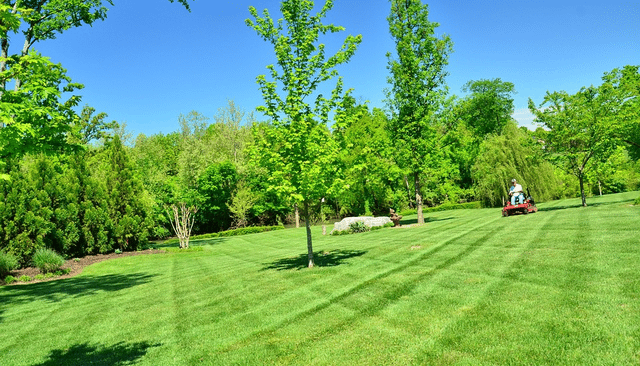Latest News
How to properly care for your lawn

Proper care is essential for a healthy lawn. This basically includes regular and above all correct lawn mowing and an adequate supply of nutrients. Here are the best tips for lawn care from the Lawn Mowing Service.
Clean regularly
Light and air are the be-all and end-all: “Regularly remove clippings and leaves, otherwise unsightly stalks and bare spots quickly arise.
Scarify
Scarifying serves to free the lawn from moss and matting. Dying plant parts become matted over time, this layer gradually thickens and hinders the access of water, light, and air. To prevent this, the blades of the scarifier cut the moss layer and tear it out of the ground. The partially cut roots are stimulated to new growth. Warning: the knives must not penetrate too deep into the ground, otherwise the weeds can germinate quickly. After scarifying, the felt has to be removed from the lawn with the rake. The ideal time to scarify is spring. If necessary, lawn seeds can now be sprinkled into the slots: 10 to 15 g of lawn seeds per square meter.
Aerify
When aerifying, you use a fine-toothed digging fork to pierce many small holes in the ground. This will aerate the lawn and significantly improve water supply.
Then spread fine quartz sand over the holes and rake it in with a rake. As a result, the holes remain more permeable to water and air in the long term.
Fertilize
After scarifying or aerating, fertilization should be carried out: Spread the fertilizer as evenly as possible. Because where there is no fertilizer, much less lush green lawn will grow later. A good gritter is of great help here. A rule of thumb for the amount of fertilizer is 25 g / sqm. Also, pay attention to the labeling of the fertilizer manufacturer.
Slow-release fertilizers should be used, which only slowly and evenly release their fertilizers to the lawn.
If you would like to know more about instant turf in Melbourne visit Lilydale Instant lawn
Fertilize again to the same extent in the second half of the growing year. The ideal time is in September, well before the end of the growing season. If the second fertilization is applied too late, the plant is stimulated to grow again and is then susceptible to frost damage when the first frosts break-in.
Weeds
Weeds are most effectively combated with weed killers in the spring cure. Follow the manufacturer’s quantity recommendations exactly. The agents contain chemical substances that are not entirely harmless. In any case, weed killers are only necessary if the unwanted plantlets appear heavily because, with good fertilization, a healthy lawn plant is even able to displace the weeds.
It is also a matter of taste whether you want a weed-free English lawn or a colorful flower meadow.
Water
If you want to have a lush green lawn, you cannot avoid watering in dry periods: If there is no rain for more than a week, you should water. The basic rule is better longer and more intense than short and frequent. The sprinkler should run on each segment for at least 45 minutes. The soil is soaked through and through and the capillary action in the lower soil layers is restored. The best time of day for blasting is early morning, better in the evening when the sun has already lost its effects. Never water under direct sunlight – this would burn the lawn!
Utilization of grass clippings
Lawn pruning is not waste – use the natural garden tool to cover planting areas. The layer should not be too thick so that there is no rotting. Beetles, earthworms and many other insects find ideal living conditions under the mulch cover and the water balance in the soil is improved.
If you do not want to mulch, you should create a compost heap. Here too, the layer must not be too thick to prevent rotting. Use branches and twigs for ventilating intermediate layers.
So-called mulch mowers do without the grass clippings: they process the clippings in their closed housing and immediately bring them back into the lawn surface. This means that the nutrients in the mown stalks and the water they contain immediately benefit the lawn again.
Sebastian was born and raised in the busy city of Abbottabad. As a journalist, Saad Mushtaq has contributed to many online publications including the PAK Today and the Huffing Post. In regards to academics, Saad Mushtaq earned a degree in business from the Abbottabad UST, Havelian. Saad Mushtaq follows the money and covers all aspects of emerging tech here at The Hear Up.Thanks










